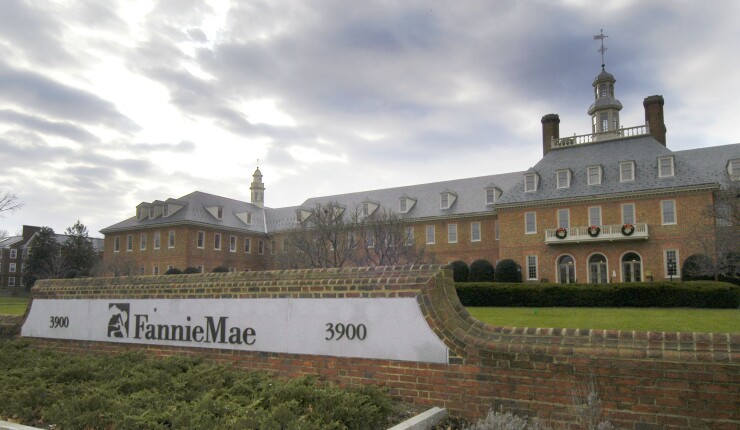Fannie Mae said it earned $5 billion in the fourth quarter, doubling its profits from a year earlier with a big boost from gains on derivatives the company uses to hedge risk.
The profit means Fannie, which has been under U.S. control since 2008, will send a $5.5 billion dividend payment to the Treasury in March, the Washington-based mortgage-finance giant said Friday.
The company had net income of $5 billion in the fourth quarter, compared with $2.5 billion in the same period in 2015, according to a regulatory filing. Net interest income, which includes fees the company charges to guarantee mortgages, was $5.8 billion compared with $5.1 billion, it said in the filing.
Fannie executives on a call with reporters said that the housing market remained stable and that the company expected to remain profitable in the long term. They did note factors such as quarterly changes in interest rates that could cause short-term losses or even require another infusion of taxpayer aid.
The company said fourth quarter earnings were driven in part by a rise in long-term interest rates. The higher rates bolstered the value of derivatives that Fannie uses to hedge interest-rate risk. In quarters where rates have fallen, the reverse has been true.

Timothy J. Mayopoulos, Fannie's chief executive officer, also said that if U.S. lawmakers follow through on pledges to cut corporate taxes, that could lead the company to cut the value of deferred tax assets it uses to offset them, leading to a large, one-time loss.
"There's no effective way for us to build any kind of a buffer to absorb any kind of a loss. I don't think there's very much we can do about that," Mayopoulos said in an interview.
Friday's report brought Fannie's net income for 2016 to $12.3 billion, compared with $11 billion in 2015. The company's earnings, along with those of competitor Freddie Mac, have been relatively stable over the past few years, after huge swings during the financial crisis and recovery. In 2013, Fannie reported a profit of $84 billion, as it reversed crisis-era writedowns of deferred tax assets.
Under the current terms of their bailout agreements, Fannie and Freddie send nearly all of their profits to the Treasury, but don't send a dividend in times of losses. In 2017, they are allowed a capital buffer of $600 million each to absorb losses. Starting in 2018, they'll have no capital buffer under the agreement, meaning even a small loss could create the need for more taxpayer money from the $259 billion they have available from the U.S. Treasury.
That's led some advocates of the preserving the companies to argue that the Trump administration and Federal Housing Finance Agency, which controls Fannie and Freddie, should change the agreements to allow them to keep some capital. The Obama administration had rejected such calls, arguing that taxpayers were no better off if the companies withheld dividends to build capital than if they paid the dividends upfront.
Freddie Mac on Thursday said it earned $4.8 billion in the fourth quarter, compared with $2.2 billion in the same period a year earlier. Freddie executives also said the company would move to a different accounting method to decrease the volatility caused by its interest-rate-hedging derivatives.
Fannie executives said they hadn't yet decided whether to take a similar move. David Benson, Fannie chief financial officer, said the company is still weighing the costs and risks of changing the accounting method. He said Fannie's larger overall earnings mean it is less buffeted by rises and falls in the derivative values than Freddie.
The government took over Fannie and Freddie in 2008, eventually sending them bailout money of $187.5 billion. Fannie's portion of that was $116.1 billion, and after March's payment, Fannie will have paid the U.S. Treasury $159.9 billion.




